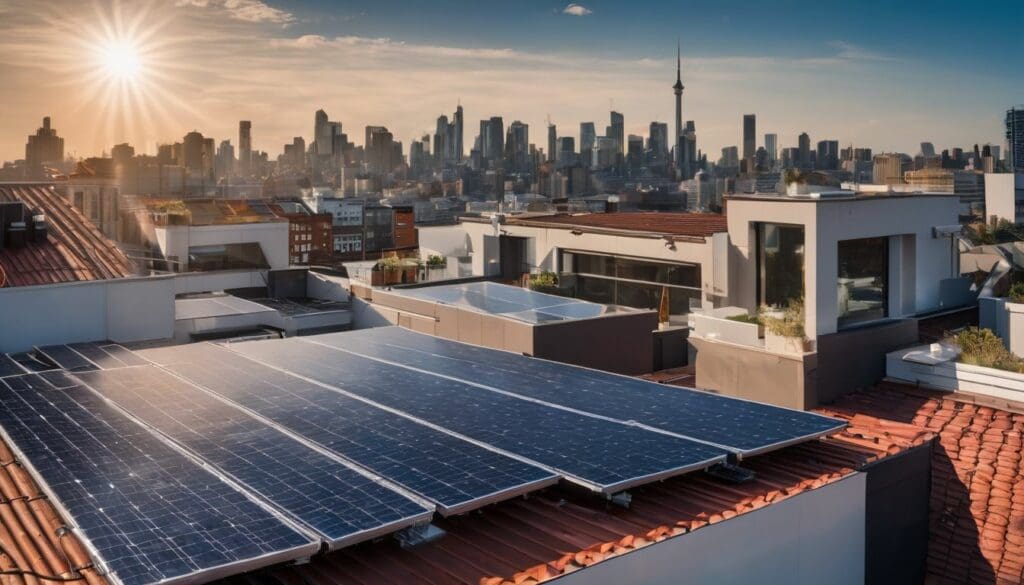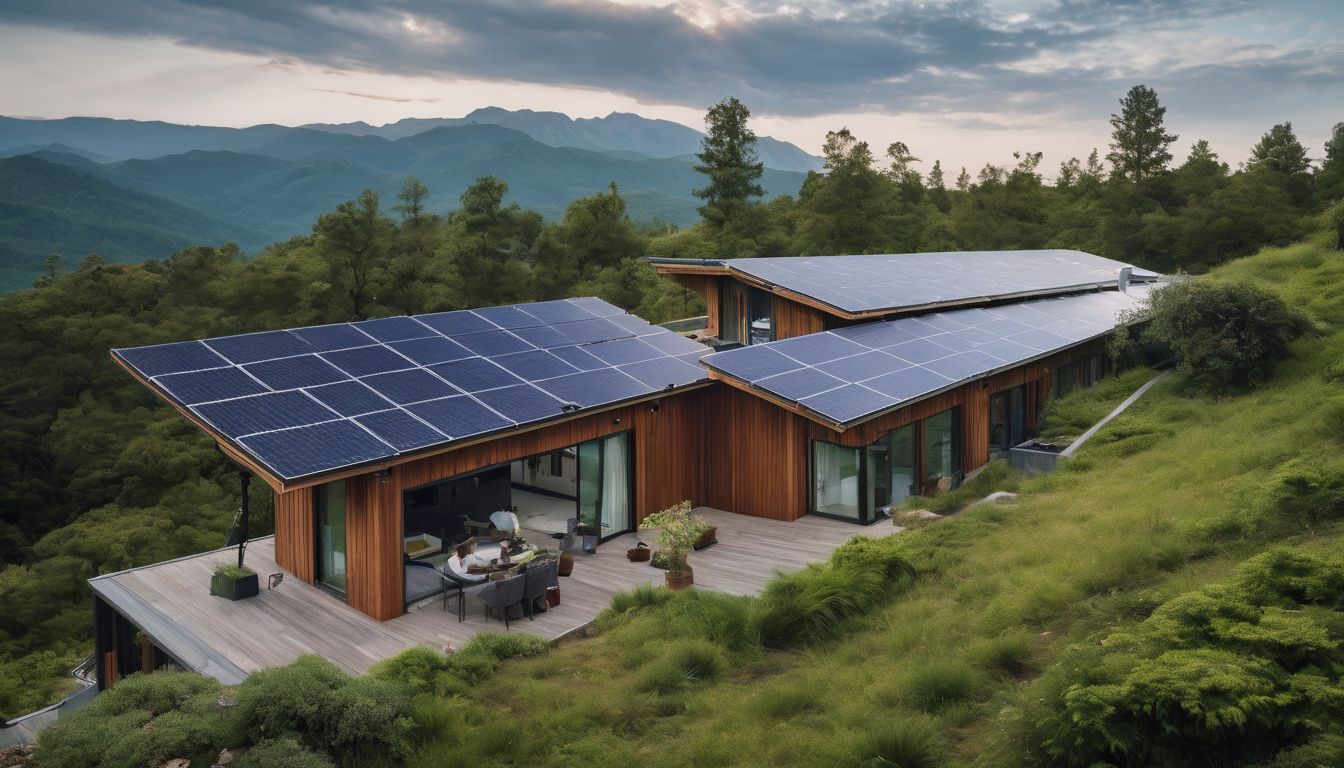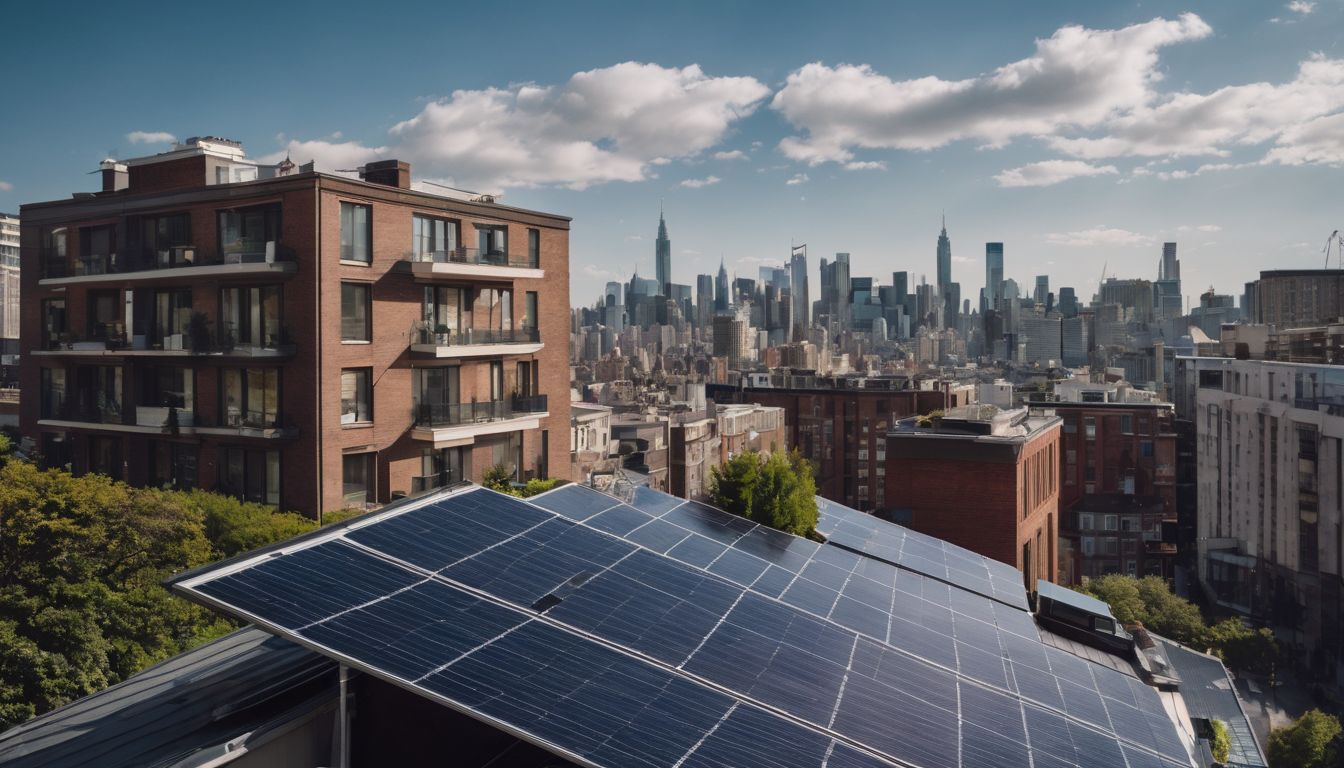Deciding to switch to solar power can be a big decision, especially when thinking about the costs. Solar energy can significantly cut electricity bills and offer tax incentives too.
This blog will guide you through various options to fund your solar project without breaking the bank. Let’s light up your journey to savings!
Key Takeaways
- Solar energy can cut electricity costs and offer long – term savings, with options like cash purchases, solar loans, leases or PPAs to make financing more accessible.
- Tax benefits, rebates and incentives from various levels of government help reduce the cost of going solar, making it a financially wise choice for homeowners.
- Home equity loans and personal loans are potential funding sources for solar installations that could increase property value while providing tax-deductible interest rates.
- Leasing programs and power purchase agreements allow homeowners to enjoy the advantages of solar power without upfront investment costs or maintenance concerns.
- Choosing the right financing option requires evaluating different loan terms, interest rates and the overall impact on your financial situation balanced against potential environmental benefits.
How Solar Panels Save You Money
Switching to solar energy can save you a significant amount of money in the long run, as it reduces your reliance on traditional electricity from the grid and lowers your monthly bills.
Additionally, there are various tax benefits and rebates available for those who invest in solar panels.
Long-term electricity costs based on monthly bills
Solar panels significantly reduce your electricity bills over time. Investing in solar energy is an efficient way to save whilst supporting environmental conservation. Here’s a snapshot of long-term savings:
| Year | Average Monthly Electricity Bill without Solar (£) | Average Monthly Electricity Bill with Solar (£) | Cumulative Savings (£) |
|---|---|---|---|
| 1 | 100 | 10 | 1,080 |
| 5 | 110 | 10 | 6,000 |
| 10 | 121 | 10 | 13,320 |
| 15 | 133 | 10 | 22,140 |
| 20 | 146 | 10 | 32,640 |
Energy costs rise annually, but solar panel users enjoy consistent bills. Tax benefits and rebates enhance savings. Solar power offers financial and environmental benefits for years to come.
Tax benefits and rebates
By taking advantage of tax benefits and rebates, you can further enhance the financial benefits of installing solar panels. Government incentives such as solar investment tax credits and renewable energy certificates can significantly reduce the initial cost of your solar energy project.
These incentives directly contribute to making solar panel financing more accessible and affordable for homeowners looking to embrace sustainable energy solutions. Additionally, rebates offered by local utility companies can provide ongoing savings, making it even more financially attractive to invest in residential solar panels.
Ultimately, understanding and capitalising on these available tax benefits and rebates will not only make your transition to solar energy more cost-effective but also demonstrate a commitment to environmental conservation through sustainable energy practices.
Types of Solar Panels and Their Costs
When considering solar panels, there are different financing options to consider. These include cash purchase, solar loans, and solar leases or power purchase agreements (PPA). Each option has its own costs and benefits that should be carefully evaluated before making a decision.
Cash purchase
When considering solar panel financing, a cash purchase offers the advantage of immediate ownership and maximum long-term savings. By purchasing solar panels outright, you can eliminate monthly loan payments and benefit from reduced electricity bills.
Additionally, opting for a cash purchase may also make you eligible for various tax incentives and rebates, further enhancing your overall return on investment in renewable energy.
With a cash purchase, homeowners can avoid interest rates associated with loans or leases while enjoying the full financial benefits of solar energy. This method is particularly appealing to environmentally conscious individuals looking to maximise their savings and take control of their energy consumption without being tied down by ongoing financial obligations related to loans or leases.
Solar loans
With solar loans, you can finance the purchase of solar panels and spread the cost over time. These loans can come from banks, credit unions, or specialised solar financing companies.
They often offer lower interest rates compared to other types of personal loans, making them an attractive option for homeowners looking to invest in renewable energy.
Solar loans typically require no money down and have flexible repayment terms. They allow you to take advantage of federal tax credits and local incentives while enjoying the immediate benefits of reduced electricity bills.
Solar leases and power purchase agreements (PPA)
After considering solar loans, it’s worth exploring alternatives such as solar leases and power purchase agreements (PPAs). With a solar lease, you can enjoy the benefits of solar energy without needing to buy the system outright.
Instead, you pay a monthly fee to use the equipment while also benefiting from any energy generated. On the other hand, with a PPA, a third-party owns and operates the system on your property.
You agree to purchase the power generated by the system at an agreed-upon rate for a specified period.
Other Costs to Consider
In addition to the cost of solar panels, there are other expenses to consider such as installation fees and maintenance costs. These additional costs should be factored into your budget when considering financing options for your solar energy project.
Installation fees
When installing solar panels, it’s essential to consider the installation fees involved. These costs can vary depending on the size of your solar system and the complexity of the installation process.
Generally, installation fees cover labour, equipment, and any necessary permits for connecting your solar panels to the electrical grid. It’s important to factor these expenses into your overall budget when evaluating different financing options for your renewable energy project.
In addition to considering various financing options for solar energy projects, understanding the potential installation fees is crucial in making an informed decision about how to proceed with your sustainable energy investment.
Maintenance costs
Solar panel maintenance costs are minimal, mainly involving occasional cleaning and inspection. On average, annual maintenance can range from £100 to £300, depending on the size and type of solar panel system.
Maintenance includes checking for debris buildup, ensuring proper wiring connections, and inspecting for any potential issues with the panels or inverters.
Regular upkeep ensures optimal energy production and extends the lifespan of your solar panels. Engaging in routine maintenance not only safeguards your investment but also contributes to a more sustainable environment by maximising the performance of your renewable energy source.
Best Ways to Finance Solar Panels
Consider options like personal loans, FHA and Fannie Mae loans, home equity loans and HELOCs, power purchase agreements or solar leases, and contractor financing to find the best way to finance your solar energy project.
Each option offers different benefits depending on your financial situation and goals.
Personal loans
Explore the option of personal loans for financing solar panels. Personal loans offer flexibility and can be used to cover the costs of purchasing and installing solar energy systems.
With competitive interest rates, a personal loan can provide an affordable way to invest in renewable energy without relying on home equity or government programs. By securing a personal loan, you can take charge of your environmental impact by harnessing solar power while also enjoying potential long-term cost savings.
To finance your solar energy project with ease, consider exploring options for personal loans which provide flexibility and affordability for investing in renewable energy. These loans offer competitive interest rates that make them suitable for covering the costs of purchasing and installing solar panels without relying on home equity or government programs.
FHA and Fannie Mae loans
FHA and Fannie Mae loans offer attractive financing options for solar energy projects. They provide accessible and affordable funding, making it easier to invest in renewable energy.
These loans often come with competitive interest rates, allowing homeowners to finance their solar panel installations without breaking the bank. By utilising these loan options, environmentally conscious individuals can take a significant step towards reducing their carbon footprint while also saving money on energy costs over the long term.
To support conservation efforts and embrace sustainable living, consider exploring FHA and Fannie Mae loans as viable financing solutions for your solar panel installation.
Home equity loans and HELOCs
Transitioning from discussing FHA and Fannie Mae loans, another viable financing option for solar panels is through home equity loans and HELOCs. By leveraging the equity in your home, you can secure a loan with favorable terms to fund your solar energy project.
With the potential increase in property value due to the installation of solar panels, this form of financing allows you to invest in renewable energy while also contributing to the conservation of the environment.
Additionally, using your home’s equity for solar panel financing provides an opportunity to benefit from tax deductions on interest payments and potentially lower interest rates compared to other unsecured options.
Power purchase agreement or solar lease
Power purchase agreements (PPAs) and solar leases are finance options that allow you to go solar with no upfront costs. With a PPA, a third-party owns the solar panels and is responsible for installation, operation, and maintenance.
You agree to buy the electricity generated at a fixed rate over the long term. On the other hand, with a solar lease, you pay a monthly fee to “rent” the system without owning it. The leasing company takes care of installation and maintenance while you enjoy lower energy bills.
These options make going solar accessible to more people by eliminating the upfront expenses associated with buying and installing panels. They also provide predictable energy costs over time without having to deal with system upkeep or repair hassles.
Contractor financing
Contractor financing is a convenient way to fund solar panel installation. Many reputable contractors offer in-house financing options which can include low or zero-interest loans, making solar energy more accessible for homeowners.
This option allows you to work with a trusted professional throughout the entire process, from choosing the right system to financing and installation.
Exploring the various contractor financing options will help you find a plan that suits your budget and renewable energy goals. Plus, by partnering with experienced professionals, you can ensure high-quality workmanship and reliable support for your solar energy project.
Next Steps in Installing Solar Panels
Comparing financing options, calculating potential savings, choosing the right solar company, understanding the installation process and monitoring system performance are all crucial steps in installing solar panels.
It’s important to carefully consider each step before making any decisions.
Comparing financing options
When comparing financing options for solar panels, it’s essential to consider the interest rates and terms of different loan options. Look into government programmes that offer incentives or low-interest loans to support renewable energy projects.
Additionally, explore solar lease agreements that may require little to no upfront costs and can provide predictable monthly payments, with the added benefit of minimised maintenance responsibilities.
Consider evaluating your home equity as a potential financing option for solar panel installation. Remember to calculate the total cost of ownership over time when comparing financing options, including any tax benefits or rebates available in your area.
Calculating potential savings
Calculate the potential savings by considering your current monthly electricity bills and the expected reduction after installing solar panels. Use a solar panel financing calculator to estimate your average monthly payment for solar panels.
Compare this with your current electricity costs to determine long-term financial benefits.
When comparing financing options, factor in tax benefits, rebates, and incentives that can further reduce the initial investment. Evaluate the return on investment over time to make an informed decision based on both environmental and financial considerations.
Choosing the right solar company
After calculating potential savings from solar panel installation, the next crucial step is choosing the right solar company. Look for an experienced and reputable solar company that offers quality products and excellent customer service.
Consider companies with good reviews and a proven track record in delivering successful solar panel installations. Verify their credentials, such as licences, certifications, and insurance to ensure compliance with industry standards.
Before finalising a decision, compare quotes from different solar companies to find the best value for your investment. Ask about their warranty terms, maintenance services, and system monitoring capabilities to ensure long-term satisfaction with your chosen solar company.
Understanding the installation process
Understanding the installation process involves several essential steps:
- Conducting a site assessment to determine the best location for solar panels based on sunlight exposure and shading.
- Securing any necessary permits and approvals from local authorities before the installation begins.
- Preparing the roof or ground mount for installation, including ensuring its structural integrity and making any necessary modifications.
- Mounting the solar panels securely onto the chosen location, ensuring they are positioned optimally for maximum energy production.
- Connecting the solar panels to an inverter, which converts the direct current (DC) electricity generated by the panels into usable alternating current (AC) electricity for your home.
- Setting up a monitoring system that allows you to track the performance of your solar energy system and identify any potential issues promptly.
Monitoring system performance
After understanding the installation process, it’s crucial to monitor system performance regularly. This involves keeping an eye on energy production levels, checking for any potential issues with the solar panels, and ensuring that the overall system is operating efficiently.
Monitoring can be done through a combination of manual checks and utilising monitoring software provided by the installation company or third-party service providers. By staying proactive in monitoring system performance, homeowners can quickly address any issues that may arise and maximise their long-term energy savings.
Regularly monitoring system performance helps ensure optimal efficiency in renewable energy production from solar panels. It provides insight into how much clean energy is being produced and allows for early detection of any maintenance needs or malfunctions within the solar panel system.
Conclusion
In conclusion, financing options for solar energy projects offer a variety of ways to make the transition to renewable energy affordable. Homeowners can take advantage of tax benefits, rebates, and various types of loans and leases to finance their solar panel installation.
Exploring these options can help individuals save money in the long run while supporting sustainable energy practices. Making an informed decision about financing is the first step towards embracing clean and renewable energy sources for your home or property.
FAQs
1. What financing options are available for solar energy projects?
There are many financing options for solar energy projects, including solar panel loans, government loan programmes, home equity financing, zero-down offers and lease options.
2. Can I get a loan to finance my home’s solar panels?
Yes, you can find various solar panel loan rates through financial institutions or specialised renewable energy financing companies that cater to residential needs.
3. Are there any interest-free financing options for solar panels?
Interest-free solar panel financing might be available with specific programmes or promotions from certain green energy financing organisations or government incentives.
4. Can I lease solar panels instead of buying them outright?
Solar panel lease options allow homeowners to use renewable energy without the upfront costs of purchasing the system; they simply make monthly payments to the leasing company.
5. Does the government offer any help with funding for residential solar projects?
Governmental support is often provided via Solar Energy Finance Options like investment subsidies or loans with favourable terms under special Government Solar Panel Loan Programmes designed to promote sustainable energy funding.
6. Is it possible to obtain clean energy financing if I want to invest in a large-scale Solar Project Funding?
Solar project funding for larger-scale investments may involve alternative energy financing from dedicated Clean Energy Financing firms or even specific Renewable Energy Financing initiatives targeting substantial Solar Energy Investment growth.





